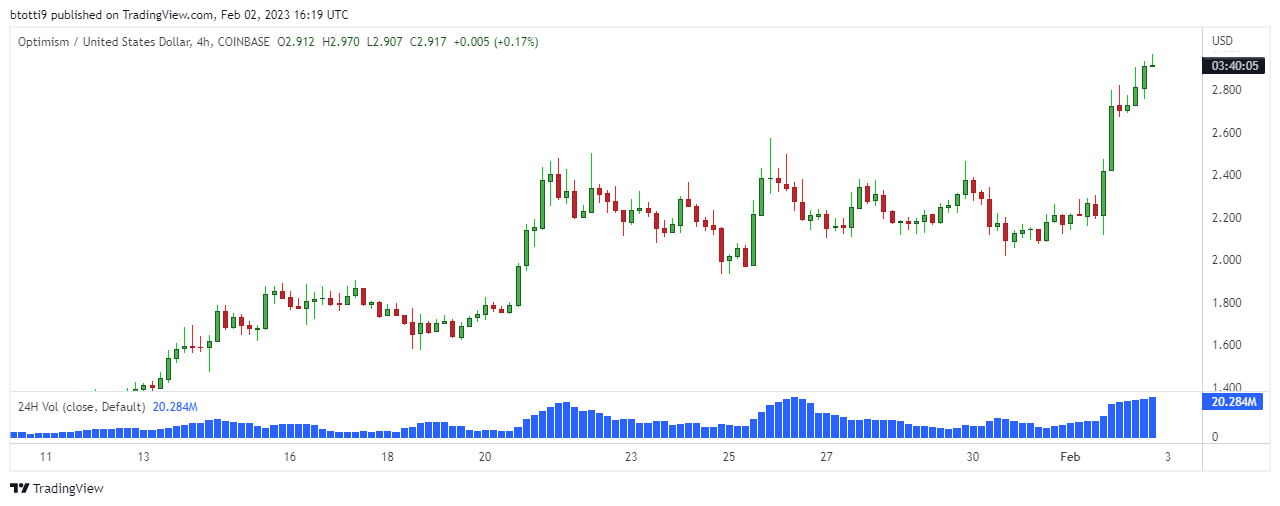- OP has rallied over 30% in the past 24 hours, reaching a new all-time high of $2.97 on Coinbase
- Optimism is outperforming major coins even as cryptocurrencies rally on Thursday.
- Gains for Optimism comes amid buying pressure after news of an upgrade proposal planned for activation on 15 March.
Optimism is rallying again as excitement around the Ethereum layer 2 scaling solution increased following a major news announcement.
As shown on the 4-hour chart below, OP reached a new all-time high of $2.97 on Coinbase. As of 11:20 am ET on 2 February, the platform’s native token OP was trading at $2.91, still up by more than 32% in the past 24 hours.
 Chart showing Optimism price rally to new all-time high on Coinbase. Source: TradingView.According to data from CoinGecko, the OP token price is up 205% in the past 30 days, outshing major coins. About 75% of the gains have come in the past two weeks as platform’s market capitalization steadily rose to currently stand around $625 million.
Chart showing Optimism price rally to new all-time high on Coinbase. Source: TradingView.According to data from CoinGecko, the OP token price is up 205% in the past 30 days, outshing major coins. About 75% of the gains have come in the past two weeks as platform’s market capitalization steadily rose to currently stand around $625 million.
Why OP token price is surging
Optimism’s gains in the past few hours have come as buying pressure ramped up ahead of what promises to be groundbreaking network upgrade.
On Wednesday, the Optimism Foundation released a proposal seeking to deploy an upgrade to the protocol’s mainnet. According to the proposal, the upgrade targets improving network performance via the Optimism Collective: Bedrock.
We’re extremely excited to put this historical proposal in front of the Token House. We see Bedrock as the culmination of years of R&D—and the next crucial step towards a modular, simplified, and performant multi-chain future.https://t.co/urk6U9aABj pic.twitter.com/ebxsvtBM8N
— Optimism (✨🔴_🔴✨) (@optimismFND) February 1, 2023
It is the first major upgrade to the Optimism protocol and brings a rollups architecture to the protocol, with transaction batching one of the main features highlighting the huge impact the upgrade could have for the blockchain’s performance.
“This upgrade offers a new level of modularity, simplicity, and Ethereum equivalence for Layer 2 solutions, providing unprecedented performance and functionality,” the Optimism Foundation wrote.
Improvements set to be added via the Bedrock release include reduced transaction fees, high throughput and improved sync speeds.
According to the team, the upgrade will not impact most users as the Optimism mainnet is “already EVM-equivalent.” However, some users including those running full and archive nodes have to take action in preparation for the upgrade.
The Bedrock proposal is expected to go through a two-week voting period, with deployment to the mainnet scheduled for 15 March if it passes.
The post Optimism price: OP surges 30% to hit new all-time high appeared first on CoinJournal.
